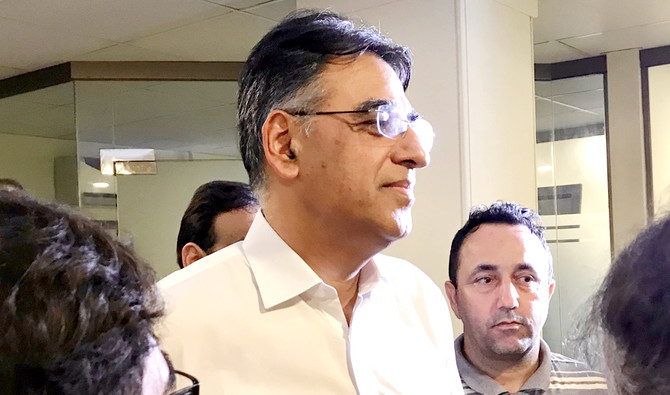ISLAMABAD: Pakistan’s finance minister-in-waiting Asad Umar said that he will not rule out loans from the International Monetary Fund (IMF) or borrowing from friendly nations as the country struggles to deal with its latest economic crisis.
Umar warned Pakistanis not to expect short-term miracles, saying the country faced growing pressure on its balance of payments — a dire economic situation that was one of the worst in the nation’s history.
“However, we came out of it earlier, and we will come out of it again,” Umar told a press conference at the Pakistan Tehreek-e-Insaaf (PTI) office in Islamabad on Tuesday.
The ruling party’s financial guru said: “By end of September, we should be able to set a direction. Urgent decisions have to be made.
“The options available are commercial borrowing and bilateral loans from friendly countries. It could be the IMF, global capital markets or overseas Pakistanis,” he said.
Pakistan’s current account deficit has ballooned to 43 percent at $18 billion from the previous fiscal year. Its foreign exchange reserves are close to rock bottom — barely enough to cover two months of imports — with a widening trade gap approaching $10.3 billion.
Meanwhile, the rupee is extremely volatile against the US dollar, falling over 14 percent in value this year, though there was a slight recovery after the July elections.
Umar blamed the former finance minister, Miftah Ismail, of Pakistan Muslim League Nawaz (PML-N) for the crisis.
“The (budget) targets were not realistic. The country was run on raw politics. The decision-making deliberately put the Pakistani economy at risk just to win an election,” he said.
“I can’t remember the last time this happened when you overshot your fiscal deficit by almost 70 percent.”
China, which is investing $57 billion in its China Pakistan Economic Corridor (CPEC), reportedly loaned Pakistan $2 billion this month in addition to previous lending.
PML-N, the outgoing ruling party of imprisoned ex-premier Nawaz Sharif, has been criticized for accepting CPEC projects at high cost. However, PTI has said it will not renegotiate the “sovereign guarantee” deals and risk foreign investments.
The party’s 2018 manifesto offers a road map to deal with economic challenges, but experts say bailout packages combined with other measures to drastically reduce debt would bring much-needed economic stability.
“The PTI government needs to take three key measures: First, they need to curtail non-essential imports; second, they need to cut fiscal deficit by bringing down government expenditure and losses of public sector enterprises; and, third, they need to expedite reform of energy sector,” economist Dr. Vaqar Ahmed, of the Sustainable Development Policy Institute, told Arab News.
Dr. Rasul Bakhsh Rais, an economist and analyst, urged the government to secure an “IMF package to meet the requirements of the fiscal deficit, and then gain the trust of the business community and overseas Pakistanis to get their foreign funds transferred.”
PTI is working on launching a dollar bond to appeal to Pakistanis abroad and a Sukook bond to raise funding for the external deficit, said Umar.
President of the Pakistan Economic Forum, Dr. Humayun Iqbal Shami, said: “China can do more in the form of rescheduling of debt repayment. The biggest trade deficit is with China, so we have to talk to China to import more from Pakistan.”
Shami told Arab News that the incoming government must focus on increasing exports. Pakistan relies heavily on imports and is regarded largely as a consumer country.
“The rupee-dollar parity should be fixed at 120 rupees. Then at least $10 billion held over speculation will flow back in to the system,” he said.













